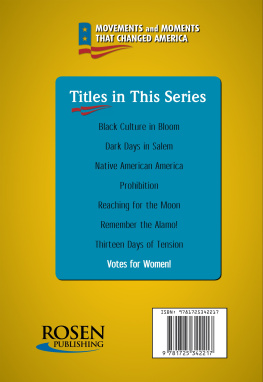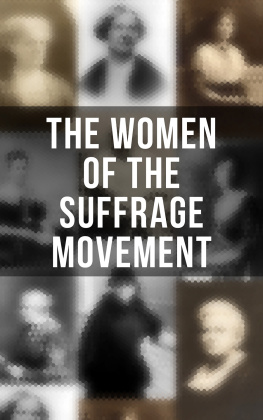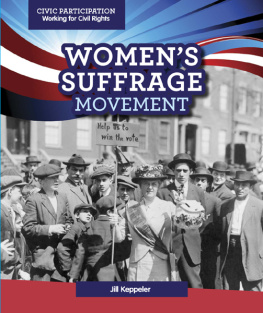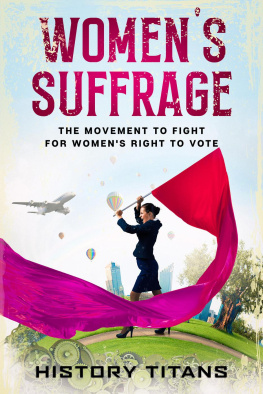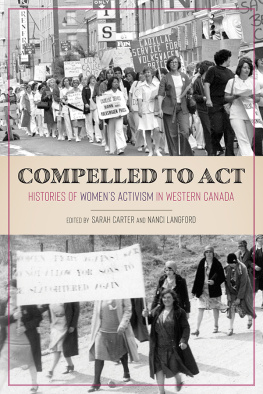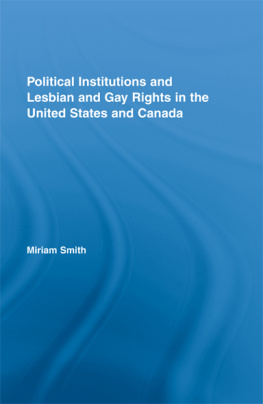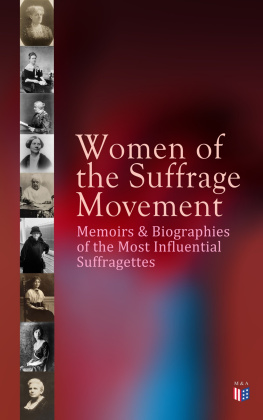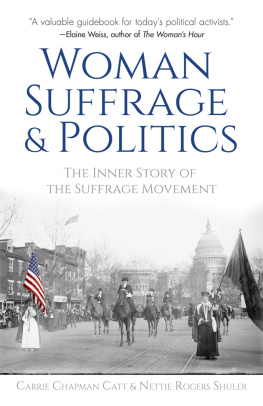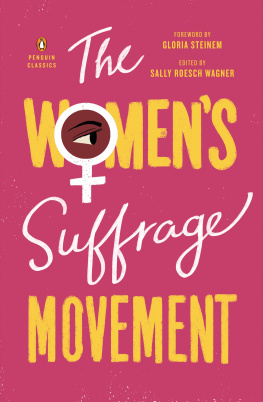The social history of Canada
MICHAEL BLISS, GENERAL EDITOR
The woman suffrage movement in Canada
CATHERINE L. CLEVERDON
WITH AN INTRODUCTION BY RAMSAY COOK

Copyright, Canada, 1950
by University of Toronto Press
Second edition 1974
University of Toronto Press 1974
Toronto and Buffalo
ISBN (casebound) 0-8020-2108-5
ISBN (paperback) 0-8020-6218-0
LC 73-82587
CN ISSN 0085-6207
Social History of Canada 18
This book has been published with the assistance of a grant from the Canada Council.
An introduction
BY RAMSAY COOK
One sign of that growing awareness was a spirited controversy over womens rights in the letters column of the Toronto Globe in February and March 1910. Allan Studholme, the Labour member for Hamilton East, had given notice of his intention to sponsor a resolution supporting woman suffrage at the forthcoming session of the Ontario legislature. Mrs Clementina Fessenden, of Hamilton, initiated the controversy by declaring her total opposition to Mr Studholmes proposal. The question, she asserted, is not one of inferiority, but of fitness; because the spheres of men and women are different, owing to natural causes; therefore their share in the public management of the state should be different. the space of the editorial columns. Here was proof, probably unintentional, of the different spheres.
Yet, within the next decade, most Canadian women were granted equal voting rights with men. But Canadian historical writing, for the most part, has continued to reflect the two spheres philosophy. This has meant that the history of woman suffrage has been largely ignored in the standard accounts of our past and has attracted little attention from research students at least until recently. The major exception is Catherine L. Cleverdons study, The Woman Suffrage Movement in Canada. Written nearly a quarter of a century ago, it remains the authoritative, indeed the only complete account of the suffragist struggle in Canada. The origin of the book is interesting, and best told in Dr Cleverdons own words:
It was written as a doctoral dissertation at Columbia University, where my adviser was Professor J.B. Brebner, an ex-patriate Canadian. Originally I had intended to write on Queen Victorias political influence, for my first love was English history. However, a book on this very subject appeared in England in the early 1940s & so that door was closed. Because of the war I couldnt go to England for research in any case, so my English history professor suggested my doing something in Canadian history. I told him I knew nothing about Canadian history. He said, Well, start reading. so I did, jotting down subjects that might do for a thesis as I went along. After making quite a list of them & checking them out to make sure no one had written anything on them, I was left with a short list of topics. Women suffrage seemed the most interesting of those available.
Though the circumstances explaining the topics choice were somewhat accidental, Miss Cleverdon obviously set out on her research with energy and skill. Since she had accepted a school-teaching position, a common necessity in the days before the graduate fellowship horn of plenty, only vacations were available for research. Consequently she took those free periods to work in Canada, using the resources of the Public Archives and the Library of Parliament. So, too, she contacted as many of the living leaders of the suffrage movement as she could trace and interviewed them. The long list of names in Augusta Stowe-Gullen, Dr Grace Richie-England, Mrs E.M. Murray, Mrs Lillian Beynon Thomas, Mrs Irene Parlby, and Mrs Nellie McClung. She also became acquainted with women in Canadian public life in the 1940s, collecting views on the small role that women had actually found for themselves after the suffrage had been gained. Professor Brebner recognized the originality and thoroughness of the resulting thesis and urged his student to prepare it for publication. In 1950 the University of Toronto Press published the first edition.
The merits of the book were obvious enough. The research was careful, the writing clear, and the organization effective. The authors sympathies with the suffragists were evident, but she let their opponents speak too. The book was well received, one reviewer remarking that it might even help to disprove the claim that Canadian history was dull.
However, the books impact was slight and its sales small and slow. It went out of print, unfortunately, just at the time that the new feminism of the nineteen-seventies might have produced a revival of interest in it. Its success in stimulating further research in the history of Canadian women was also negligible. Apart from a number of interesting, but usually unscholarly biographies, the subject received almost no further attention from Canadian historians. Women had the vote, now they had a history. Meanwhile Lauriers naval policy was in need of further analysis.
It would be interesting to speculate on the reasons for this striking lack of interest in the history of women in Canada. Certainly it was not a peculiarly Canadian phenomenon. Moreover, there is always the fact that the Canadian historical profession, at least until recently, has been so small that any subject that is covered by one whole book is lucky. There were, and are, many that have none. And since even that small profession was dominated by men, it is not surprising that what work was done on the history of women was done by amateurs. Finally, it is obviously of some significance that the book appeared in 1950 when Canadian society was entering a period of calm, complacency, and conformity. It was not that women had achieved equality, as a little pamphlet made plain in the same year. It was rather that once again, as in the 1920s, with a war over, Canadians turned more toward their private affairs and away from public crusades. Prosperity and the Liberal ascendency, ably seconded by the Bomb and the Cold War, set the climate of a country interested in economic growth, educational expansion, large families, and split-level suburbs. The minorities French Canadians, women, unorganized workers, native peoples, were quiescent, and ideology appeared to have come to an end.
The election first of John Diefenbaker and later Jean Lesage marked the end of those peaceful post-war years. In Canada, as elsewhere, the sixties were marked by a renewal of social and political unrest, accompanied by the rediscovery of ethnic, class, regional, and sexual inequalities. The French Canadians led the way but others were not far behind. The period was also characterized by an unprecedented number of royal commissions even for Canada.
The new feminism has had at least one important result for students of Canadian history: it has revived interest in the history of Canadian women. A few graduate students are beginning to pick up the story where Miss Cleverdon left off. Undergraduates ask to write term papers on women; publishers scurry to reprint the classics of past struggles though they are few enough. The long overdue republication of Dr Catherine Cleverdons The Woman Suffrage Movement in Canada is part of this new climate of interest in the study of the history of women in Canada.
While the strengths of Miss Cleverdons book are plain enough, the historian of the 1970s will doubtless ask some questions about the history of Canadian women that would not have seemed especially relevant to a writer in the 1940s. Of particular interest is the socio-economic context of the suffragist movement and the character of its ideology. Further, discussion of these areas, though occasionally repetitive of Miss Cleverdons own text, may help to explain more fully the rise of the movement and provide clarification of the reasons for its limited impact upon Canadian society. It is obvious that the demand that the franchise be given to women arose as a result of some quite substantial changes in womans status and from an accompanying change in attitudes about womans role, capacities, and responsibilities.
Next page

